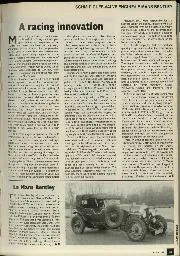
Le Mans Bentley
The 3-litre Bentley that was driven by Frank Clement and George Duller in the 1926 Le Mans 24-hour race has been laid up since the late 1970s but has now…
POINTS OF VIEW G. E. T. EYSTON ON THE MIDGET AT MONTLIIthlY.
NOW that a 750 c.c. engine has achieved a speed officially timed of nearly 115 m.p.h. it is interesting to look back on the development work which has been carried out during the year 1931.
On December 21st, 1930, the unsupercharged Midget did approximately 87 m.p.h. in records which were taken at Montlhery up to 100 kilometres. In doing this it broke the existing figures set up by a supercharged model of another make, and therefore this was a good beginning on which to base the effort to attain a much sought after project—namely to be the first to attain over 100 m.p.h. when covering an ‘ official ‘ distance.
A ” Powerplus ” supercharger was added and was chosen because of the low horsepower required to drive it, as with a considerable boost this is of extreme importance. It was necessary to insure an engine performance which would give adequate power to pull a higher gear ratio, the maximum revolutions of the engine remaining the same as with atmospheric aspiration.
For particular reasons it was imperative to continue record breaking under wintry conditions, and owing to the intense cold which prevailed, development work was extremely difficult. With the supercharger, however, record speeds were pushed up to 97 m.p.h. for 10 miles at the first attempt.
Certain modifications were then carried out to cope with the low temperature at the carburetter intake and these proved very efficacious.
On February 16th, 1931, the 5 kilometre record was broken at 103 m.p.h. and others at 102 m.p.h., thus the car was the first to achieve the 100 m.p.h. mark and this constituted a milestone in the history of motoring.
The supercharger arrangement in particular has proved its worth in many important competitions during 1931.
1st, 3rd, 7th and 10th in the R.A.C. Tourist Trophy Race, Belfast, being an example, as well as an average of over 92 m.p.h. for 500 miles in the famous B.R.D.C. Race, and the Team prize as well. Before the racing was over for the season, however, attention was again directed to record breaking, the ambitious plan being to cover over 100 miles in the hour. This may not sound easy on a 750 c.c. engined car, and not so long ago one would have been thought mad to attempt it. It means that the whole car must be 100%. It goes without saying that the engine must run at full bore without losing its tune, and there must be a reserve of power when doing over 100 m.p.h. But it is no good
having a motor without conveying the power to propel the vehicle, and the difficulties of obtaining effective adhesion between car and track on such a tiny outfit are in themselves an extensive problem. The layout of the suspension system has to be first rate and, as will be the case on all cars of the future,
adjustable shock absorbers from the dash become indispensable. The emptying of the petrol tank during the run on such an occasion constitutes a little worry in itself, and this has to be taken care of in the adjustable strength of the suspension.
The class of lubricant used in the engine must be of the highest quality, and additional provision for cooling the oil a sine qua non. It so happened that a model after the style of the Tourist Trophy winner was used for the attempt with
the standard sized blower as employed on the road racers. Therefore, the car was in no way a freak. In this way success represented a sheer speed and endurance test for what was virtually a standard production model, and thus its value was increased twofold. On the 25th of September, 1931, the attack was made. A gentle start, until things got warmed up to it, meant that after quarter of the distance had been covered
the car had to lap Montlhery track at about 104 m.p.h. continuously.
Actually over 101 miles were covered in the hour and although the driver had an anxious time watching all the instruments and manipulating the controls, the run was accomplished with the greatest regularity.
This only went to prove that development of the 750 c.c. car had reached an advanced stage, sufficient in fact for all practical purposes.
What the ultimate speed of a 750 c.c. engine would be in 1931 was somewhat intriguing, and in order to get some idea of this an M.G. engine was placed in a single seater chassis.
So well had the layout of this been planned that little trouble was experienced in the tuning up, so that it became possible to do over 110 m.p.h. at the first attempt.
Just before Christmas, iu spite of a further cold spell, further records were tackled up to 10 miles, with the result that close on 115 m.p.h. was attained, and this with consistency over 5 kilometres, 5 miles, 10 kilometres and 10 miles.
Whether or no these speeds can be improved remains to be seen.
Anyhow the results so far are extremely encouraging.